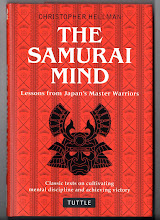Occasionally, you get to watch strategy at work in national or world events as they play out around you. Although not privy to all the details, it can be fascinating to observe events as they unfold, with an eye to the moves and the tactics of the main players.
The Ozawa Situation
I have never been particularly interested in politics, and politics in Japan, even less so, but the current situation in Japan is just too interesting to ignore. Ichiro Ozawa, the 'kingmaker' is making a bid for the throne. He is not a popular politician with the public at large, and his name has been besmirched over the last few years with the taint of financial scandals, but he has emerged ready for a fight for the leadership of his party, the DPJ, and the country itself.
It is the stuff novels are made of - the backroom politicking must be intense. Setting aside personal opinion, what is obvious is that Ozawa is a master of the game. He has built up his influence and support, allowed Yukio Hatoyama, the ex-prime mimister to take the blame for reneging on impossible election promises, let his successor, Naoto Kan, work off the inevitable resentment and unpopularity arising from the current strength of the yen against foreign currencies, and is now poised to step in before Kan has really had a chance to get to work.
But how has he got this chance? The unfathomable rules governing political parties seem to dictate that elections for leadership should take place within the party on a regular, unchanging basis - never mind that the current leader has just taken over the reigns of power, now he has to battle to hold onto his position as well as lead a country. Never mind, also, that polls show 75% of the country see no reason to change leadership, the situation allows Ozawa to fight in an arena where he holds most of the cards, in the closed arena of his own party. Far easier to win here than in a general election. He has even threatened to leave the party if he doesn't win... a strange move for a man who says he has the party's best interests at heart.
And why? Cynics would say it's naked ambition. The chances of being able to win the next election are already looking slim - it will probably be back to business as usual with the LDP in power, and the DPJ might not get another look-in for 10 years or more, so he is probably right in thinking that if he doesn't take a shot now, he will never become PM.
Of course, it's all politics, but now is a fascinating chance to watch a master at work.
Sunday 29 August 2010
Tuesday 24 August 2010
Matsuura Seizan -swordsman and scholar

Matsuura Seizan is an unusual and interesting figure - a kind of 'renaissance man' - but little known in the west, which is a pity, as he left unusually clear and informative writings on the art of swordsmanship from the point of view of a master swordsman. I first got interested in him when I began to translate the Joseishi Kendan, (which is included in my forthcoming The Samurai Mind, published by Tuttle), and the more I found out, the more I became interested in him. Like Musashi, he was a master of both 'bun' and 'bu', but his background and life were quite the opposite of that more famous swordsman.
He was born as the oldest son of the daimyo of Hirado, an island just off the coast of western Kyushu, near Nagasaki, and after the death of his father, became lord of the domain at the age of 16. His position in society allowed him access to a variety of famous men of his age, and he was connected to a group of philosophers, artists and literary types in the Osaka-Kyoto area that was associated with Minagawa Kien, the Neo-confucian philosopher, and included luminaries such as the painters Maruyama Okyo and his student Nakagawa Rosetsu. While he doesn't write about art, his works clearly show his Confucian scholarship.
He was clearly a character of some discipline as well as administering his domain, he studied several different styles of martial arts, including archery, spear, jujutsu, riding, gunnery, and most famously Shingyoto ryu kenjutsu. He also became well known as a writer later in his life, especially for a long-running series of essays on miscellaneous oddities of Edo. Education was another of his concerns, and he founded a domainal school, the Ishinkan, which provided education both in martial and academic disciplines, allowing students of different styles to train together.
Nowadays he is chiefly remembered for his literary works, including those he wrote on the sword, principally Kendan and Kenkou, which present a mixture of advice and stories for students of the art of swordsmanship. Throughout, his erudition and intellectual honesty shine through, though only occasionally do we glimpse the more forthright, combative side of his nature.
This is shown more fully from other sources. Later in life, reports told of an old man who would roam the outskirts of Edo by night, handing out beatings to anyone who anyone who dared try his skill. He carried an old broken bowstave as a cane and a short sword at this waist, and would appropriate the swords of the losers as a penalty for their presumption. It is said that the numbers of those he defeated ran into the dozens and included several who later became famous for their skill with the sword. Of course, this was Matsuura Seizan himself - he would have been in his seventies at the time.
Labels:
history,
Martial arts,
sword,
swordsmanship,
The Samurai Mind
Subscribe to:
Posts (Atom)









